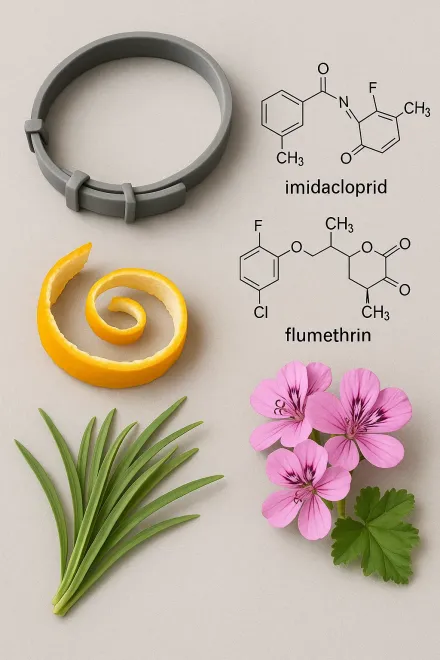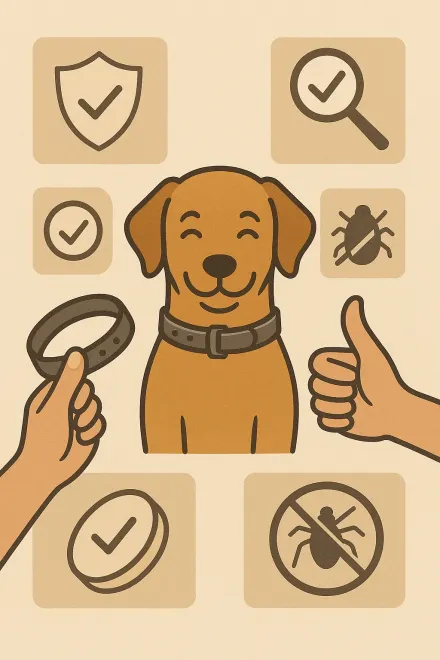Flea and Tick Collars for Dogs
Flea and tick collars are one of the most effective, long-lasting, and convenient solutions to protect your dog from parasites like fleas, ticks, and lice. On this page, we’ve selected the highest-rated collars on Amazon to help you find the one that best fits your dog’s size, age, and lifestyle.
Whether you live in the countryside, take your dog on nature walks, or simply want to prevent infestations, a quality flea collar is a smart investment in your pet’s health. Discover top brands, read comparisons, and buy at the best price.
View Flea and Tick collars on Amazon
Why Should You Use a Flea and Tick Collar for Your Dog?
Flea collars are highly recommended by veterinarians to protect dogs from fleas, ticks, lice, and other external parasites that can harm their health and wellbeing. Unlike spot-on treatments or tablets, flea collars release active ingredients gradually and consistently for weeks or even months, providing continuous protection without the need to reapply frequently.
This kind of protection is especially useful for outdoor dogs, as it helps prevent infestations even in high-risk environments. They’re easy to put on, comfortable to wear, and very safe when the right model is chosen. Some collars also protect against mosquito-borne diseases like leishmaniasis and heartworm, making them a complete solution for preventive care.
Choosing the right flea collar helps protect not only your dog, but also your home—since parasites can spread throughout the house. Investing in an effective and long-lasting product is a smart and responsible choice.
What Active Ingredients Should a Good Flea Collar Contain?
Common active ingredients in flea and tick collars include:
- Imidacloprid and Flumethrin: A highly effective combination against fleas and ticks (used in collars like Seresto).
- Permethrin: A strong insect repellent—not safe for cats.
- Natural extracts: Such as citronella or geraniol—ideal for sensitive dogs or as a gentle preventive option.
The right active ingredient depends on your dog’s environment, sensitivity, and age. Always consult your vet before choosing a flea prevention method.


Tips for Choosing the Best Flea Collar for Your Dog
Choosing the right flea collar can protect your dog more effectively and help you avoid health issues and costly vet visits. Here are the key things to consider:
- Longevity: Choose collars that provide long-lasting protection, ideally from 3 to 8 months. This way, you can skip monthly treatments and ensure year-round protection.
- Compatibility: Make sure the collar is suitable for your dog’s size, age, and breed. Some are not recommended for puppies, senior dogs, or those with sensitive skin.
- Water resistance: If your dog swims, gets wet in the rain, or enjoys the beach, look for a waterproof collar that remains effective after exposure to water.
- User reviews: Reading Amazon reviews from other dog owners can provide insight into real-world effectiveness and durability—especially for dogs similar to yours.
- Safety & tolerance: If your dog has a history of allergic reactions, consider natural or hypoallergenic formulas. Always check with your vet if unsure.
- Price vs. quality: Cheaper collars might seem like a good deal, but may be less effective or last shorter. It’s often worth investing in a trusted brand with proven results.
The best flea collar balances effectiveness, comfort, and safety. Not every collar fits every dog, so take time to compare before making your choice.
Frequently Asked Questions About Flea Collars for Dogs
How long does a flea collar last?
It depends on the brand and model. Premium flea collars like Seresto offer up to 8 months of continuous protection against fleas, ticks, and other parasites. Budget collars typically last between 2 and 6 months. Always check the packaging for duration details and mark the application date to know when to replace it.
Are flea collars safe for all dog breeds?
In general, yes. Most flea collars are formulated to be safe for dogs of various breeds and sizes. However, you should always choose a collar based on your dog’s weight, age, and skin sensitivity. If your dog has allergies or sensitive skin, opt for natural ingredients or consult your vet before use.
Do flea collars work against leishmaniasis?
Some collars, like Scalibor, are formulated to repel mosquitoes, including the sandfly that transmits leishmaniasis. If you live in a high-risk area (warm, humid, or rural zones), using a mosquito-repellent collar is very helpful. For full protection, combine it with spot-ons, mosquito nets, or preventive vaccination.
Can I bathe my dog while they wear the flea collar?
It depends on the collar. Many flea collars are water-resistant and safe to keep on during occasional baths or if your dog gets wet. However, frequent water exposure (like swimming) can reduce the collar’s effectiveness. Always read the manufacturer’s guidelines. If not waterproof, remove the collar before bathing and put it back on once dry.
Can I use a flea collar along with other treatments?
In some cases, yes. You can combine a flea collar with spot-on treatments if they target different parasites. However, you should never overlap active ingredients that could cause overdosing or side effects. Always check with your vet before combining products to ensure your dog’s safety.
At what age can a dog start wearing a flea collar?
Most flea collars are safe for puppies from around 7–8 weeks old, though this varies by product. Always read the label carefully. Avoid using flea collars on very young puppies, nursing mothers, or pregnant dogs unless recommended by a vet.
